
While in Bergen to lecture at the university I came across a couple of signs that begged to be photographed. It seems like kebab and pizza are always together here, even under the mantra of nirvana.

While in Bergen to lecture at the university I came across a couple of signs that begged to be photographed. It seems like kebab and pizza are always together here, even under the mantra of nirvana.
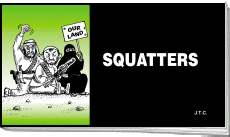
Most people find it hard to take cartoons seriously, apart from political satire and that can become a deadly issue, depending on the target. Given the recent Danish cartoon controversy it would seem that comics and religion do not mix well or at least settle well for the believers who see themselves as the target. But what about comic relief for the political struggle between Israel and the Palestinians? Fundamentalist tract artist Jack Chick, whose comic empire is dedicated to winning souls for Christ by drawing on God’s hate, has been using his pen to spread a rather sinister version of the fundamentally reduced Gospel for over 40 years. One of his more recent offerings is called “The Squatters†and it provides a virtual roadmap to apocalypse. Continue reading Tabsir Redux: Apocalypse Watch: The Man Who Knows Squat

Note: The Qur’an can be divided into thirty equal parts. One part takes only twenty-four reading minutes, and the whole Book requires 12 reading hours. There are 114 chapters, and 6,236 Arabic verses (Abu ‘Amr Al-Dani in his book Al-Bayan), containing 77,439 Arabic words (reported by Al-Fadl bin Shadhan) made up of 371,180 Arabic letters (Abdullah b. Kathir reporting Mujahid, although there are different accounts). By contrast the King James Version of the Christian Bible (OT and NT) has 783,137 words and 3,566,480 letters. Muslims believe the Quran in Arabic is the actual Word of God given to Muhammad through a series of revelations from 610-632 C.E. and not written down as a “book†until after Muhammad died.
Given the general ignorance in American society of Islam, especially the theology based on the teachings in the Quran, it is important to go back to the beginning, the essence, the opening, the words that are by definition significant to all Muslims. This eloquent key is the opening (fatiha) of the text, a set of verses as repeated by Muslims daily as the Lord’s Prayer is by Christians. Continue reading Tabsir Redux: Opening the Qur’an
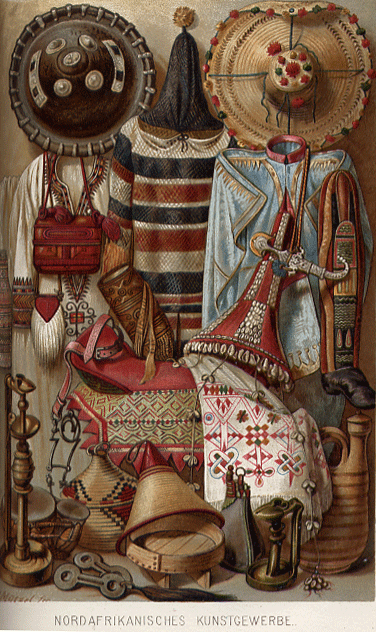
One of the most important German geographers of the late 19th century was Friedrich Ratzel (1844-1904), whose three-volume Völkerkunde (Leipzig and Vienna, Bibliographisches Institut, 1890) is one of those encyclopedia cultural accounts that circulated just as the discipline of anthropology was getting off (in this case literally “on”) the ground. While now a text for curiosity rather than critical scholarship on peoples and cultures, Ratzel’s work is still a fascinating portrayal of cultures being colonized for both revealing the biases of the day and the then-contemporary illustrations of people and material culture. My university library recently divested itself of uncirculated books in storage and one of these was an 1890 edition of the third volume on “Die Kulturvölker der Alten und Neuen Welt.” Whether it was the eye-watering althochdeutsch script of the volume or the mere fact it was written in German, no student or professor at Hofstra ever checked this volume out.
In salvaging a third of Ratzel’s opus for a mere dollar, I could not help but be drawn to the illustrations, mostly lithographs but with a few beautiful color plates. Continue reading Tabsir Redux: With Ratzel in North Africa
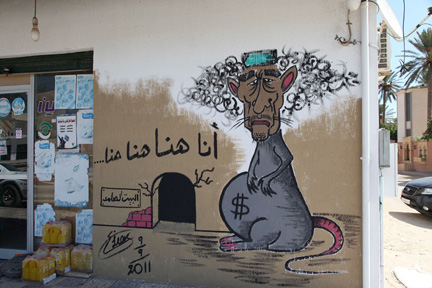
Al Jazeera has collected a gallery of street graffiti on the overthrow of Libya’s still-on-the-run Qaddafi. Check out the site for all the images.
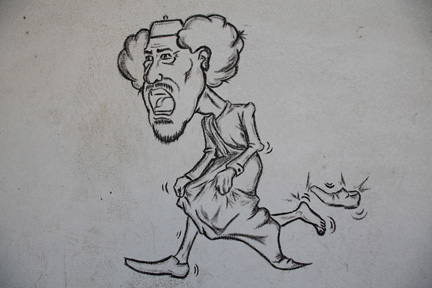
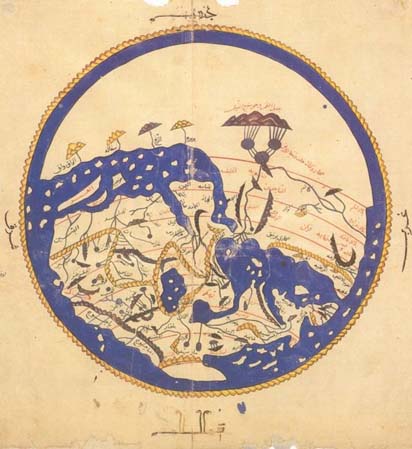
Al-Idrisi’s map of the world, 1154 CE
A very useful volume on Islamic cartography is now online. Below is the table of contents, each chapter available in pdf.
Volume Two, Book One
Cartography in the Traditional Islamic and South Asian Societies
Edited by J. B. Harley and David Woodward
Volume 1
Front Matter
Gallery of Color Illustrations (Plates 1–24)
Gallery of Color Illustrations (Plates 25–40)
Preface
J. B. Harley and David Woodward
Part One – Islamic Cartography
Chapter 1. Introduction to Islamic Maps
Ahmet T. Karamustafa
Chapter 2. Celestial Mapping
Emilie Savage-Smith
Chapter 3. Cosmographical Diagrams
Ahmet T. Karamustafa
Early Geographical Mapping
Chapter 4. The Beginnings of a Cartographic Tradition
Gerald R. Tibbetts Continue reading History of Islamic Cartography Online

Palestine and Israel are back in the news. As Abbas prepares to request recognition for Palestine from the U.N. and Israelis themselves stage protests following the “Arab Spring,” the installation (sans clothing) photographer Spencer Tunick has returned to the legendary site of Sodom and Gomorrah to unclothe the political tensions in the area. I think he is on to something by having his subjects take everything off. Forget about turning swords into plowshares, just strip and dive in. And here is one part of the region where you are guaranteed not to sink.
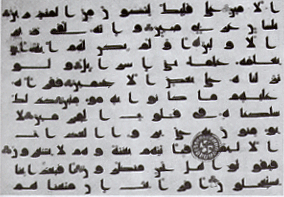
Kufic Quran, second/eighth century
by John F. Healey and G. Rex Smith
The Kufic Quran has reached its fully developed form by the end of the second/eighth century. It was invariably written on parchment, the letters in a black ink with dots, often red and green (the latter used with initial hamza) though sometimes in gold only, representing short vowels, and black strokes, single and double, distinguishing letters. The text thus written is made difficult by the spacing which would seem to be more to do the calligrapher’s artistic inclinations and his desire to justify his text precisely than with Arabic orthography. “Justification†here refers to what became the standard practice in printed books of making the lines even in length both at the beginning and at the end of the lines. Verse endings and other pauses call for gold: usually a cluster of three balls, one sitting on two others and quite elaborate roundels. Continue reading Arabic in Kufic Script